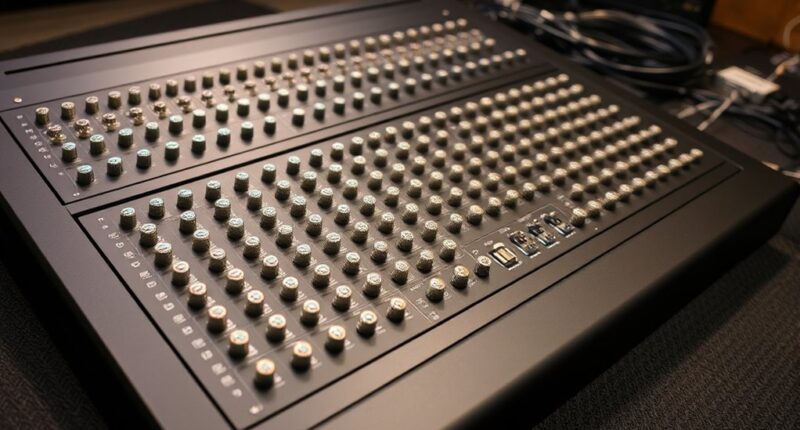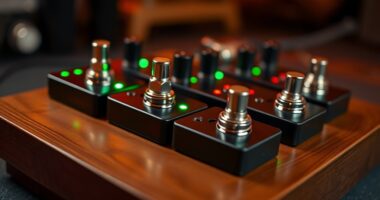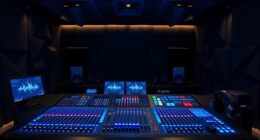If you’re looking for the top patchbays with 48 TRS points, I recommend considering models like the Black Lion Audio PBR, Behringer PX3000, and ART P48-48, which combine high-quality construction with versatile routing options. These units offer durable design, gold-plated connections, and flexible switch modes that suit complex studio setups. Some are more premium, while others are budget-friendly but still reliable. To find the best fit for your needs, check out detailed features and compare them closely.
Key Takeaways
- Look for patchbays with fully shielded, durable construction and gold-plated TRS connectors for optimal signal integrity.
- Prioritize models offering versatile routing modes like Normal, Half-normal, Thru, and Open for flexible studio setups.
- Choose units with clear visual indicators, accessible front-mounted switches, and easy patching to streamline workflow.
- Consider size, rack-mount compatibility, and weight to ensure secure installation and easy access in your studio space.
- Balance price and features, selecting premium options for professional reliability or budget models for basic, reliable patching.
Black Lion Audio PBR TRS3 LIT 48-point Gold-plated TRS Patchbay

If you’re looking for a reliable patchbay designed for professional studio or stage use, the Black Lion Audio PBR TRS3 LIT 48-point Gold-plated TRS Patchbay is an excellent choice. It features 48 TRS connections with gold plating to guarantee top signal integrity. The compact rackmount design makes it perfect for studio setups or live environments, while its full flexibility allows for various routing configurations with per-module switches for Normal, Half-normal, and Thru modes. Built with durable materials like a reinforced-steel chassis and black-anodized aluminum faceplate, it’s made to withstand frequent use. The customizable LED indicators add visibility, making complex routing straightforward.
Best For: professional audio engineers, studio owners, and stage performers seeking a durable, high-quality patchbay for reliable signal routing.
Pros:
- Gold-plated TRS connections ensure optimal signal integrity
- Fully customizable with per-module mode switches for flexible configurations
- Robust construction with reinforced-steel chassis and durable faceplate
Cons:
- Relatively heavy at 9.85 pounds, which may require sturdy mounting solutions
- Higher price point due to premium materials and features
- The complexity of setup may be overwhelming for beginners unfamiliar with patchbay routing
Behringer Ultrapatch Pro PX3000 48-point 1/4 inch TRS Balanced Patchbay

The Behringer Ultrapatch Pro PX3000 stands out as an ideal choice for professional studios seeking reliable, flexible signal routing. With 48 points of 1/4 inch TRS connections, it helps reduce cable clutter and keeps your setup organized. Each channel supports switching between Parallel, Half-normalled, Normalled, and Open modes, offering maximum versatility. Its rugged construction and high-quality components ensure long-lasting durability. Designed specifically for professional audio applications, this patchbay simplifies signal management and improves clarity. If you need a dependable, flexible patchbay to streamline your studio’s workflow, the PX3000 is a solid option worth considering.
Best For: professional audio engineers and studio setups seeking reliable, flexible signal routing with durable, high-quality patch management.
Pros:
- Reduces cable clutter and enhances studio organization
- Supports multiple switching modes (Parallel, Half-normalled, Normalled, Open) for maximum flexibility
- Rugged construction and high-quality components ensure long-lasting performance
Cons:
- May be more expensive than basic patchbays, impacting budget-conscious setups
- Installation and configuration might require some technical knowledge
- Limited to professional audio applications, less suitable for casual or home studio use
ART Pro Audio P48-48 Point Balanced Patch Bay

The ART Pro Audio P48-48 Point Balanced Patch Bay stands out as an ideal solution for professionals seeking organized, reliable connectivity in their studio or live sound setups. This 19-inch rack-mountable unit is fully shielded, providing excellent interference protection. It efficiently organizes cables, reducing clutter and simplifying signal routing. Plus, it helps minimize wear and tear on your audio equipment connectors, extending their lifespan. Whether you’re working in a professional studio, home setup, or installed audio environment, the P48-48 offers durable, high-quality performance, making it a versatile choice for maintaining a clean and reliable audio workflow.
Best For: professional and home recording studios, installed audio systems, and live sound setups requiring organized and reliable cable management.
Pros:
- Fully shielded design provides excellent interference protection
- Facilitates efficient cable organization and signal routing
- Reduces wear and tear on audio equipment connectors, extending their lifespan
Cons:
- May be more expensive than simpler patch bay options
- Requires rack space and installation in standard 19-inch racks
- Limited to balanced audio connections, not suitable for unbalanced or other signal types
Black Lion Audio PBR TRS3 LIT 48-point Gold-plated TRS Patchbay

Designed for professional studios and stage setups, the Black Lion Audio PBR TRS3 LIT offers 48 premium TRS connections with gold plating that guarantee ideal signal integrity. Its compact rackmount design combines durability with elegance, featuring a black-anodized aluminum faceplate and reinforced-steel chassis. Each of the 48 patch points has per-module mode switches, allowing quick toggling between Normal, Half-normal, and Thru configurations. The vivid, customizable LED indicators provide clear visual cues, while the 3-way routing switches add flexibility for complex setups. With audiophile-grade quality, this patchbay simplifies signal routing and assures reliable performance during demanding recording or live performances.
Best For: professional audio engineers, studio setups, and live sound technicians seeking a durable, flexible, and high-quality patchbay for complex routing.
Pros:
- Gold-plated TRS connections ensure optimal signal integrity and durability
- Fully configurable with per-module switches for versatile routing options (Normal, Half-normal, Thru)
- Compact, robust rackmount design with customizable LED indicators for clear visual status
Cons:
- Slightly heavy at nearly 10 pounds, which may impact portability for mobile setups
- May be more expensive compared to basic patchbays without gold-plated connectors
- Requires some technical knowledge to fully utilize all configurable routing options
dbx PB-48 Point Patch Bay black

If you’re setting up a professional studio and need reliable, noise-free access to your audio gear, the dbx PB-48 Point Patch Bay black is an excellent choice. It features 48 ¼” jacks on both front and back panels, making rerouting quick and straightforward. Its 1U rack-mountable design fits seamlessly into your setup. Built with rugged metal, it’s durable enough to withstand daily use and reduces wear on your equipment’s jacks. This patch bay enhances workflow efficiency while maintaining sound clarity, ensuring your studio stays organized and reliable. Overall, it’s a solid, long-lasting solution for professional audio environments.
Best For: professional audio engineers and studio setups seeking reliable, noise-free patching solutions for organized and efficient workflow.
Pros:
- Provides 48 ¼” jacks on both front and back panels for flexible routing
- Rugged metal construction ensures durability and long-term use
- 1U rack-mountable design fits seamlessly into standard studio racks
Cons:
- May be more expensive than basic patch bays without metal housing
- Requires rack space, which might be limited in smaller setups
- Installation and wiring could be complex for beginners unfamiliar with patch bays
Samson S Patch 48 Point Patch Bay

For audio professionals seeking an affordable, straightforward patch bay with 48 balanced TRS connections, the Samson S Patch 48 Point Patch Bay offers a practical solution. It features 48 fully balanced, half-normalled, and pass-through connections in a compact rack space. While it delivers solid sound quality without noise or dropouts, some users report issues with build quality, especially the exposed circuit boards and sockets that require forceful patching. Patching can be tricky, with sockets jiggling and difficulty inserting plugs. Despite these concerns, it remains a budget-friendly option for basic patching needs, especially if you prioritize affordability over rugged durability.
Best For: audio professionals on a budget who need a straightforward patch bay with balanced connections for basic patching tasks.
Pros:
- Solid sound quality with no noise, hiss, or dropouts
- Fully balanced 1/4 inch patch points with half-normalled and pass-through modes
- Compact design fitting into a single rack space
Cons:
- Build quality issues, especially with exposed circuit boards and sockets needing forceful patching
- Difficult to insert plugs, causing sockets to jiggle and patching to be cumbersome
- Limited to half-normalled and pass-through modes, lacking full normal operation
Hosa MHB-350 8-Point 1/4 Inches TRS Balanced Patchbay Module
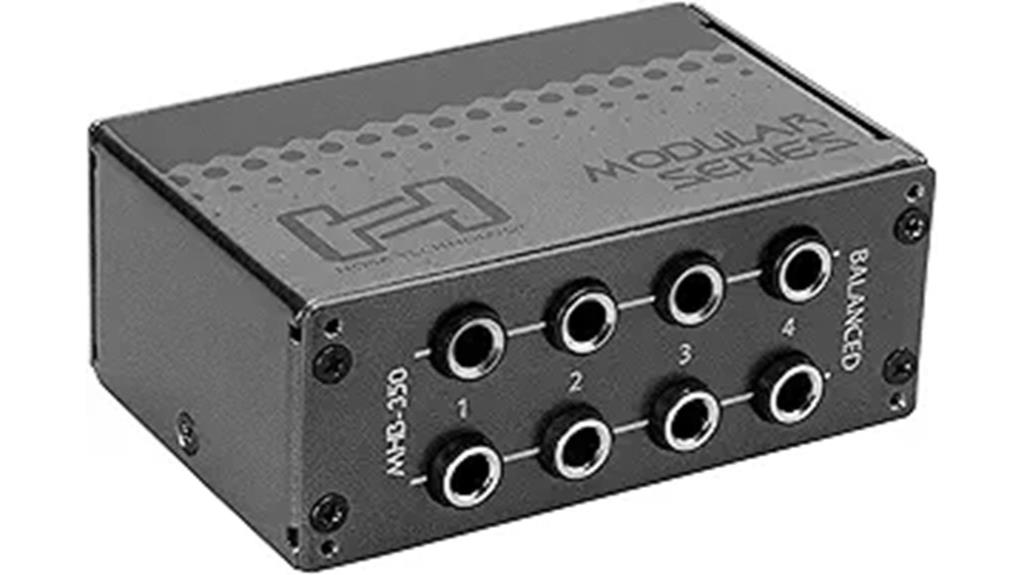
The Hosa MHB-350 8-Point 1/4 Inches TRS Balanced Patchbay Module is an excellent choice for professionals who need reliable, high-quality signal routing between mixers, recorders, and outboard gear. Its compact design measures just over 10 inches, making it easy to incorporate into any setup. With eight channels of balanced TRS throughput, it supports versatile and flexible routing for various audio equipment. Made from durable steel with a sleek black finish, it’s built for longevity and consistent performance. Supported by ongoing manufacturer assistance, the MHB-350 delivers dependable, high-quality connections, making it a solid option for professional studio environments.
Best For: professionals seeking a durable, reliable patchbay for high-quality balanced audio connections in studio or live sound environments.
Pros:
- Supports 8 channels of balanced TRS signal routing for versatile setup options
- Compact and durable steel construction with a sleek black finish for longevity
- Easy to integrate with various audio equipment due to compatibility with standard 1/4-inch TRS connectors
Cons:
- May be limited for users needing more than 8 channels of routing
- Requires power source, which could add to setup complexity
- Not suitable for unbalanced or different connector types without adapters
Black Lion Audio PBR TRS Patchbay

The Black Lion Audio PBR TRS Patchbay stands out as an excellent choice for professional studio engineers who demand reliable and flexible signal routing. It features 96 gold-plated TRS connectors, ensuring superior signal quality. The mode-switching buttons allow quick configuration between Normal and Half-normal modes, offering versatile routing options. Its durable black-anodized aluminum faceplate gives it a sleek, professional look and withstands frequent use. Users appreciate its solid build and performance, though some note the back-mounted buttons require careful planning during setup. Overall, this patchbay combines high-quality construction with flexible operation, making it ideal for demanding studio environments.
Best For: professional studio engineers and audio professionals seeking a durable, high-quality TRS patchbay for reliable signal routing and flexible setup.
Pros:
- High-quality gold-plated TRS connectors for superior audio signal transmission
- Mode-switching buttons enable quick and versatile configuration between Normal and Half-normal modes
- Durable black-anodized aluminum faceplate provides a professional look and withstands frequent use
Cons:
- Mode-switching buttons are located on the back, requiring careful planning during installation
- Accidental hits on the back-mounted buttons can occur during patching, potentially disrupting setup
- Slightly heavier and larger footprint may require dedicated space in the studio setup
Hosa CSS-830 Balanced Patch Cables, 1/4 Inch TRS to Same, 1 Foot
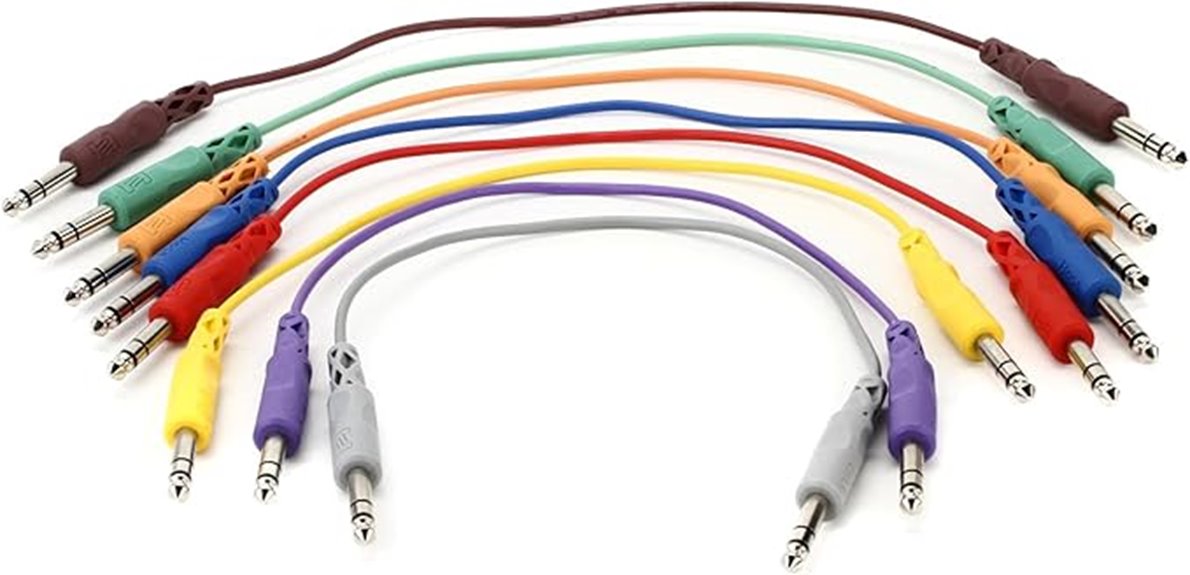
Hosa CSS-830 Balanced Patch Cables are ideal for audio professionals seeking reliable, high-quality connections in their studio or live sound setup. These 1-foot cables feature nickel-plated TRS connectors, ensuring rugged durability and secure connections. The flexible design, combined with OFC spiral shields, effectively rejects EMI and RFI interference, maintaining signal integrity. Using oxygen-free copper conductors, these cables provide clear, noise-free audio transmission. While sold from abroad and possibly differing slightly from local options, they’re a dependable choice for patching between patchbays and other studio gear. Their compact length makes them perfect for tight, organized setups.
Best For: audio professionals and studio enthusiasts seeking durable, high-quality patch cables for reliable signal transfer in tight or organized setups.
Pros:
- Nickel-plated TRS connectors for enhanced durability and secure connections
- Effective EMI and RFI rejection due to OFC spiral shields
- Oxygen-Free Copper conductors for clear, noise-free audio
Cons:
- Sold from abroad, which may affect availability and support
- Slight variations from local products in fit, labeling, or instructions
- Only available in a 1-foot length, limiting flexibility for longer runs
Art Pro Audio TPatch – Eight Point Balanced Patch Bay

If you’re looking for a compact, reliable patch bay for studio desktop organization, the Art Pro Audio TPatch stands out with its eight balanced 1/4-inch TRS connections. It offers flexible routing with four linked input/output pairs and switchable normal or half-normal modes, making it versatile for various setups. The all-aluminum case ensures durability, and passive operation means low maintenance. While it’s ideal for line-level signals and studio patching, it’s not suited for speaker-level connections or straight-through patching. Customers appreciate its reliability and sturdy build, making it a solid choice for protecting gear and managing cables efficiently.
Best For: musicians, audio engineers, and studio enthusiasts seeking a durable, compact patch bay for line-level signal routing and cable management in desktop or pedalboard setups.
Pros:
- Reliable passive operation with minimal maintenance
- Durable all-aluminum case for long-lasting use
- Flexible routing options with switchable normal and half-normal modes
Cons:
- Not suitable for speaker-level signals or straight-through patching
- Ports and buttons may feel slightly cheap to some users
- Limited to line-level applications, restricting its use for certain audio setups
Black Lion Audio PBR TT LIT 96-point Gold-plated TT/DB-25 Patchbay

For professional studios seeking maximum flexibility and durability, the Black Lion Audio PBR TT LIT 96-point patchbay stands out with its gold-plated TT and DB-25 connections. Its 96 TT connectors guarantee high-quality signal transfer, while the 12 DB-25 ports expand routing options. The patchbay features a customizable LED display and a ground connector to minimize hum. Built with a black-anodized aluminum faceplate and reinforced-steel chassis, it’s designed for reliability and longevity. Compact and lightweight at 12.3 pounds, it’s perfect for demanding recording environments. With over 10,000 switch cycles tested, this patchbay offers peace of mind in professional studio setups.
Best For: professional recording studios and stage setups seeking a durable, high-quality patchbay with extensive connectivity options.
Pros:
- Offers 96 gold-plated TT connectors for superior signal integrity.
- Includes 12 DB-25 ports for versatile routing and expansion.
- Built with a rugged black-anodized aluminum faceplate and reinforced steel chassis for durability.
Cons:
- Hefty at 12.3 pounds, which may require secure mounting.
- Higher price point reflecting premium features and build quality.
- Limited availability or delayed shipping, as it first became available in December 2024.
Factors to Consider When Choosing a Patchbay 48‑Point TRS

When selecting a 48-point TRS patchbay, I focus on key factors like mode switching options, which affect versatility, and signal integrity quality to guarantee clear audio. Durability and compatibility are also vital, so I look for sturdy build and flexible patching options that fit my setup. Ease of patching and user comfort help me work efficiently without frustration.
Mode Switching Options
Choosing the right mode switching options is essential for maintaining efficient and flexible signal routing in a 48-point TRS patchbay. Modes like Normal, Half-normal, and Thru enable various routing configurations tailored to your studio needs. Fully customizable switches let you quickly change signal paths without unplugging cables, saving time and effort. Per-module switches provide precise control over each patch point’s operation, ensuring ideal setup for different workflows. The placement of switches, whether on the front or back panel, influences ease of access and overall workflow efficiency. It’s also important that these switches are durable, tested for thousands of cycles, so they remain reliable over time. Well-chosen mode switching options make your studio setup adaptable and dependable.
Signal Integrity Quality
High signal integrity in a 48-point TRS patchbay depends on several key factors that guarantee clean, reliable audio transmission. Gold-plated connectors are essential because they reduce oxidation and ensure low contact resistance, maintaining a solid connection over time. Balanced TRS connections help minimize noise and interference, especially during long cable runs, preserving audio quality. High-quality patchbays feature modular switching options that prevent signal degradation when reconfiguring setups. The materials used in construction, like reinforced-steel chassis and anodized faceplates, shield against electromagnetic interference, enhancing clarity. Proper grounding and grounding connectors are also crucial, as they significantly reduce hum and noise. Together, these factors ensure your patchbay delivers optimal signal integrity for professional studio performance.
Build Durability
Durability is a critical factor to factor in when selecting a 48-point TRS patchbay, as it directly impacts its longevity and reliable performance over time. A sturdy metal chassis and high-quality materials ensure the device can withstand frequent handling without damage. Gold-plated connectors are essential for preventing corrosion, maintaining consistent connection quality over years of use. Reinforced faceplates and shock-resistant mounting hardware further enhance durability, protecting against accidental impacts and wear. The design should support repeated patching cycles without degrading internal components or performance. Well-made mode switches and locking mechanisms help prevent accidental disconnections or damage during operation, ensuring the patchbay remains reliable even with regular use. Overall, build durability safeguards your investment and keeps your studio setup running smoothly.
Compatibility Flexibility
When selecting a 48-point TRS patchbay, ensuring compatibility flexibility is essential to creating a versatile and efficient studio setup. First, verify that the patchbay supports your specific connector type—TRS—to match your equipment and avoid connection issues. Next, check its mode-switching options—Normal, Half-normal, Thru—to match your desired signal routing needs. Compatibility with your operating system and any control software, like LED indicators or customization features, is also vital for seamless operation. Additionally, consider whether the physical connectors and mounting options fit your studio’s layout, ensuring smooth integration. Finally, review if the configuration options—such as multiple modes per port—offer the adaptability needed for complex routing scenarios, making your setup more flexible and future-proof.
Patching Ease and Comfort
Choosing a 48-point TRS patchbay that prioritizes patching ease and comfort can considerably streamline your workflow. Clear labels and accessible switches make switching between Normal, Half-normal, and Thru configurations quick and straightforward, saving valuable setup time. Ergonomically designed patch points require minimal force, reducing finger fatigue during frequent patching sessions. Front-mounted controls allow for fast adjustments without reaching behind the unit, enhancing efficiency. The tactile feedback from switches or buttons confirms mode changes, preventing accidental misconfigurations. Additionally, a well-organized layout with logical port grouping minimizes clutter and makes it easier to identify and patch signals accurately. Overall, these features create a more comfortable and intuitive experience, enabling you to focus on your work without unnecessary frustration.
Visual Indication Features
Clear visual indication features are essential for efficient patchbay operation, as they allow you to quickly identify signal status and mode settings at a glance. Look for patchbays with customizable LED indicators that clearly display whether a connection is active or inactive, helping prevent routing mistakes. Color-coded or illuminated switches make it easier to see the current setup during adjustments, especially in dimly lit environments. If the patchbay has digital or software-based indicators, ensure they’re compatible with your system for seamless integration. Comprehensive visual feedback for modes like Normal, Half-normal, and Thru is vital to avoid errors. Durable, high-contrast LEDs or displays that remain visible in various lighting conditions significantly enhance operational efficiency, ensuring you can work confidently and swiftly.
Size and Rack Fit
Selecting the right size and rack fit for your 48-point TRS patchbay is crucial to guarantee smooth operation and future expandability. First, measure your available rack space carefully to ensure the patchbay’s dimensions match your setup. Decide whether a 1U, 2U, or larger rack-mount size best suits your current equipment and plans for expansion. Check the physical size and weight to confirm it can be securely mounted without strain or imbalance. It’s also important to verify that the front panel and rear connections are compatible with your patch cords and cabling setup. Finally, choose a size that allows easy access for setup, troubleshooting, and routine adjustments, preventing any hassle during operation. Proper sizing ensures a seamless integration into your studio environment.
Frequently Asked Questions
How Do I Properly Label and Organize a 48-Point TRS Patchbay?
To properly label and organize a 48-point TRS patchbay, I start by numbering each connection clearly, either with labels or color codes. I keep a detailed map or diagram of my setup, noting what each patch point connects to. I also group related connections together and use consistent labeling conventions. Regularly updating and maintaining this system helps me stay organized and quickly troubleshoot when needed.
What Are the Maintenance Tips for Ensuring Patchbay Longevity?
Think of your patchbay as the heartbeat of your studio—keeping it healthy is key. I regularly dust it off and use contact cleaner on the TRS connections to prevent corrosion. I also guarantee cables are properly seated and avoid excessive bending. Periodically checking for loose connections and keeping it in a cool, dry spot helps prevent wear. Proper maintenance keeps your patchbay singing smoothly for years to come.
Can a 48-Point TRS Patchbay Handle Multiple Signal Types Simultaneously?
Yes, a 48-point TRS patchbay can handle multiple signal types simultaneously, like audio, MIDI, or control signals, depending on its design. I make sure to check the patchbay’s specifications to confirm compatibility with different signals. Using proper cabling and labeling helps me prevent cross-talk or signal degradation. It’s a versatile setup that helps me keep my studio organized and efficient, even with diverse connections.
What Troubleshooting Steps Are Recommended for Connectivity Issues?
Ever felt like your patchbay’s playing hide and seek with your signals? When troubleshooting connectivity issues, I start by checking all connections for loose or faulty cables—sometimes, a simple reseat does the trick. I then verify the patchbay’s routing settings, test with different cables, and make certain the connected gear functions properly. If problems persist, I inspect for any damage or corrosion, making sure everything’s clean and secure.
Are There Compatibility Concerns With Different Brands of TRS Patchcables?
Yes, compatibility can be a concern with different brands of TRS patch cables. I’ve found that sticking to reputable brands guarantees better quality and consistent connections. Cheaper or generic cables might have inconsistent shielding or connectors, which can cause noise or signal loss. Always check the specifications and opt for cables that match your patchbay’s requirements. This way, I ensure reliable, high-quality connections for my studio setup.
Conclusion
In wrapping up, I hope this whirlwind of wisdom helps you choose the perfect patchbay for your studio setup. Whether you’re after affordability, advanced features, or impeccable build quality, these options deliver diverse designs and dependable performance. Remember, a well-chosen patchbay provides peace of mind and precise control. So, take your time, trust your taste, and transform your space with a top-tier TRS patchbay that truly tackles your technical needs.
